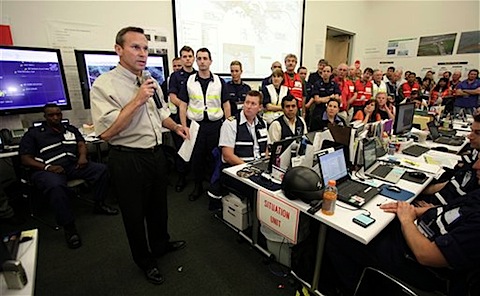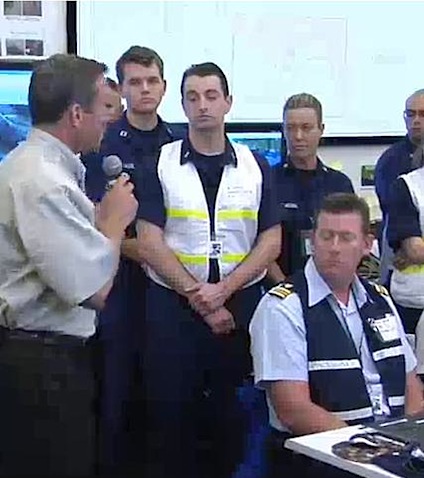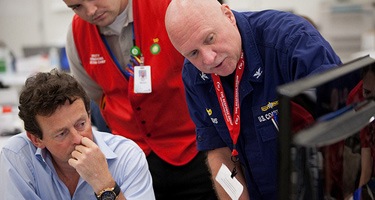Somebody at BP has been reading The Onion.
BP has figured out that dressing their employees in groovy outfits can help build esprit, camaraderie and a even a sense of importance.
Okay, I’m being snarky here… but I am wondering about the positive (and possibly negative) effects of the outfits these BP control center personnel are wearing.
Check out these three photos of BP team members.
When I was viewing a video of a morale-boosting speech by COO Doug Suttles, my attention was drawn to the array of work vests sported by the control center members in the audience. Further investigation of photos of BP employees at several different “command centers” show that these vest are common attire.
You can see the array of vest and their features more clearly in the video, but a quick look at the photos here should suffice.
Almost all the control center employees in the photos on the BP website, with the exception of Suttles (and later, Hayward), are wearing vests.
The idea that control center personnel need to wear color-coordinated vests with reflective safety stripes is intriguing to me. What’s this all about?
Take a look at these photos, and take note of the vests. There are at least four colors of vests.
Each vest has a large label that stretches across the back. On the front is a built-in name tag holder, where some individuals have name tags. Other individuals wear name tags on lanyards, some of which are then tucked into the name tag pocket.
Vests as uniforms.

These vests, like uniforms, as much about communicating information about the wearers as they are about being functional.
The vests, serving as uniforms:
- Define this aggregation of individuals as one “group”,
- Allow for fine, controlled distinctions within the group,
- Provide some physical, body-related, functions, and
- Project the organization’s desired values and attributes to members and to outside viewers
Colored Vests Create Unit
Wearing the bests puts all the vest wearers in the same group e.g., we’re all command center staffers. It’s easy to tell that a vested person is part of the command team. It’s easy for an incoming member to take the vest of an outgoing member and just stick his or her name tag in the holder…. personnel are interchangeable, as long as they are wearing the appropriate vest.
BP’s Colored Vests Create Differences
Note who isn’t wearing a vest. Doug Suttles, COO, wears a crisp, short-sleeved dress shirt. With a tasteful BP logo on the chest. The color– uniform khaki — is subtly workmanlike and uniform-like (for example, the shirt is not pinstriped or faint plaid, which would make it more like a business shirt). It’s neither white-collar nor blue collar; instead, it’s “official”. Suttles is the only person I can see who is wearing this kind of logo shirt. I guess that makes it easy to tell that he’s from HQ.
BP’s Colored Vests Coordinate Groups
The different colors of vests indicate difference work groups. In addition, the large labels on the back of the vests note which sub-team team that person is assigned to (e.g., Coast Guard Situation). Both from the back and from the front, it’s as easy (if not easier) to tell the person’s sub-team than it is to tell anything else about them.
Colored Vests Cover Possibly Important Differences

You’d think that the (only) people willing to put on a BP-issued vest would be BP employees themselves.
However, not everyone in a vest is a BP employee. Note these four individuals to Suttles’ right in the this photo at left. All four of them are also wearing Coast Guard uniforms, and the fellow seated in front of the computer is actually a Coast Guard Officer.
I find the symbolism of Coast Guard Officers and Coast Guard Persons to wearing BP vests a little bit disconcerting. On the one hand, yes, this could mean that everyone, regardless of the company, service branch or agency that they come from, is part of the team. And, it could also mean that the authority of the people in uniforms is subordinated to the group represented by the vest they are wearing — in this case, BP.
I also wonder whether, among the Coasties, having an officer wearing a vest over his or her uniform influences the authority relationship. What’s it like for a Guardsperson to take direction from a BP manager when her or his officer is seated nearby? Does wearing the vest neutralize the Officer’s authority over . Or both meanings. It certainly doesn’t look like the Coast Guard or anyone else from the US government is in charge here.
The Physical Functionality of the Vests
Sometimes, uniforms are also functional (e.g., they have pockets & tool loops, they are waterproof or insulated). These vests seem primarily to be about distinguishing group members rather than providing some kind of physical comfort or service to them.
Given the array of possible ‘uniform’ items, I can understand why these folks might be wearing vests instead of other uniform elements. Baseball caps are too sporty (plus, rude to wear indoors). T-shirts are much too casual (it’s not a fun run or concert).
Haz-mat Jumpsuits, like the ones worn by the folks cleaning the beaches, would just be overkill (and hot). Vests are easy to put on, take off, trade with your friends. And, they’re one-size-fits-all.
But what’s with the reflective stripe?
There is one feature of the vests that is odd to me: the reflective stripe.
Most of the vest have either white or safety-yellow reflective stripes across both front and back. The strips make these vests look like ones worn by a road construction crew member. But what’s the function of the safety stripe?
Outdoors, in the fog, dusk or dark, the stripe increases other people’s ability to see that there is a person there. But inside the control centres, the stripe serves no “real” purpose. What then might be the symbolic purpose?
- Maybe the reflective stripe makes them feel like “safety workers”?
- Maybe the reflective stripe makes them feel like they are more physically attached to “cleanup” (rather than to data on screens)?
- Maybe the reflective stripe protects not the workers’ bodies, but instead protects the workers’ psyches… maybe the reflective stripes make the vest feel like protection for the team members, telling reporters and other audiences that these folks are working hard to fix the problem?
 As a team-builder, I like the coordination provided by the vests. As a former Girl Scout, I like the camaraderie encouraged by the vests. As a US Citizen, I distrust the way the vest prioritizes BPs authority over the Coast Guard’s. But putting myself in the shoes vest of one of these individuals?
As a team-builder, I like the coordination provided by the vests. As a former Girl Scout, I like the camaraderie encouraged by the vests. As a US Citizen, I distrust the way the vest prioritizes BPs authority over the Coast Guard’s. But putting myself in the shoes vest of one of these individuals?
If I was working with BP, I think I might appreciate the psychic protection of the vests the most.
Photo Credits:
BP COO Doug Suttles talks to Houma LA Joint Information Center employees, AP Photo/Charlie Neibergall, on CBNews.com
Other photos from BPs website page: Command Centre, BP, and clipped from the Suttels Visits the Houma Team video.
 I am an organizational consultant, change advocate, and organizational identity/reputation scholar with a PhD in leadership & organizations. I research, write about, and consult with organizations on the relationships between organizational identity, actions, and purpose. I teach Technology Management, part-time, at Stevens Institute of Technology.
My current research focuses on how social technologies in the workplace can drive organizational change, generate meaning, and catalyze purpose. See the
I am an organizational consultant, change advocate, and organizational identity/reputation scholar with a PhD in leadership & organizations. I research, write about, and consult with organizations on the relationships between organizational identity, actions, and purpose. I teach Technology Management, part-time, at Stevens Institute of Technology.
My current research focuses on how social technologies in the workplace can drive organizational change, generate meaning, and catalyze purpose. See the 
Comments on this entry are closed.